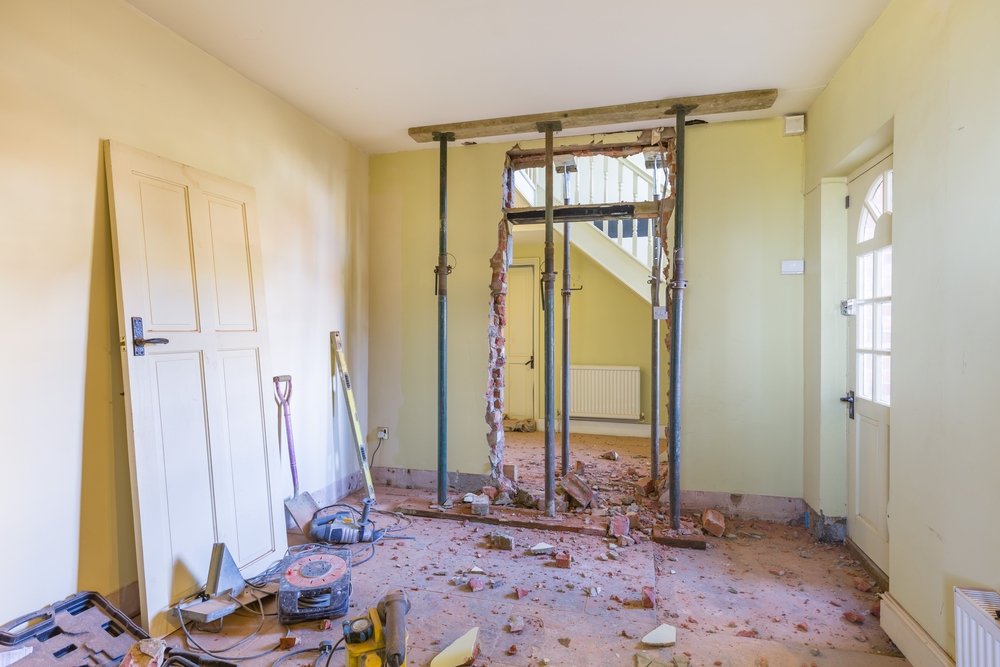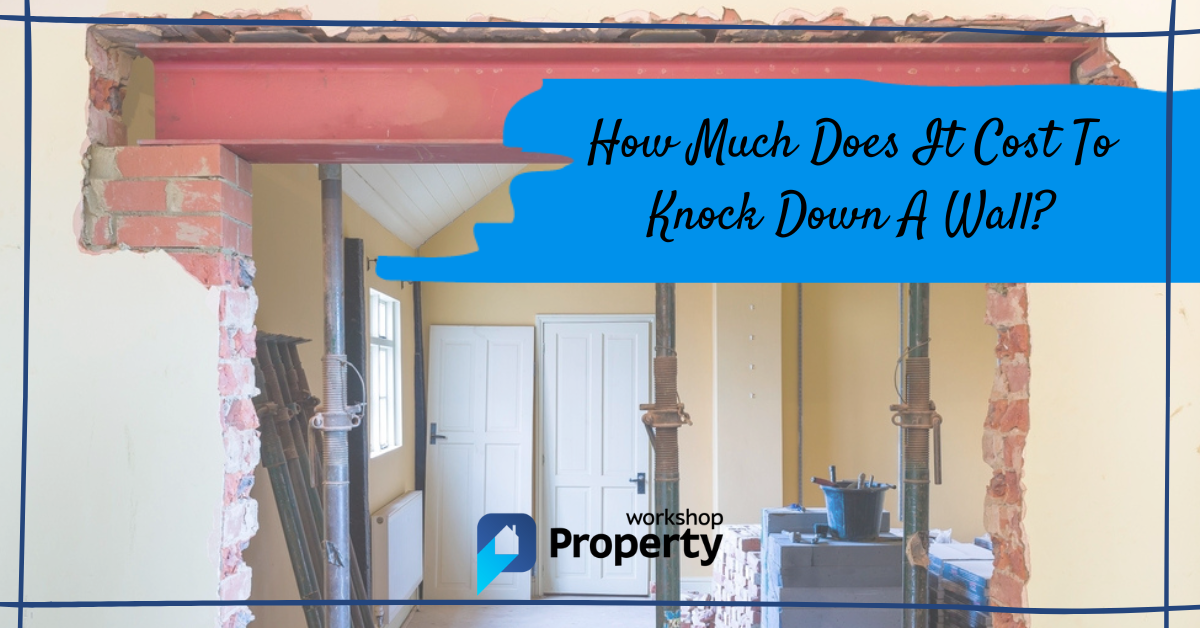There’s much more to think about when knocking down a wall than simply breaking out the sledgehammer and impersonating a wrecking ball.
The size of the wall, its relation to other load-bearing structures and the quality of work required all affect the cost of knocking down a wall.
This guide considers key questions, such as whether to do the job yourself or outsource it to a professional.
Having knocked down my first brick wall (with some parental help) at 14, I’ve spent the last twenty years advising homeowners and DIYers on similar activities. And when it comes to demolishing a wall, there’s more to think about than you might initially realise.
In a Hurry? Find top-rated builders in your area by clicking the button below:
External and Internal Walls
Things are relatively simple if the wall you’re knocking down is in the garden.
By contrast, knocking down an internal wall becomes a major logistical exercise.
External
You don’t need to worry about dispersing the dust that will inevitably come from dismantling a solid structure, and a boundary wall is unlikely to support anything of significance.
Internal
Any rooms surrounding the work area will be temporarily uninhabitable, slowly disappearing under a thick layer of dust.
Internal walls may also comprise several layers (brick or breezeblock with plasterboard on both sides). In contrast, an external wall is typically bare brick or stone with only a single layer to tackle.
Load-Bearing Walls
Unless one external wall is somehow propping up an adjacent structure, you should be able to remove it without knock-on effects.
For internal walls, you must check if it’s load-bearing or not before knocking them down.
Suppose you’re punching a hole in a brick wall, for instance. In that case, you’ll have to consider the load-bearing nature of that wall, which probably interconnects with other adjacent brickwork and might be supporting ceiling joists (or upper storeys).
Chipping out extra bricks and inserting a steel lintel is a considerable undertaking that requires heavy lifting equipment and several people.
It’s not a job a sole DIYer can easily undertake, though the cost of hiring professionals rises significantly if several people are needed to lift a new RSJ into position.
Pro Tip: Professional builders can temporarily support the ceiling on a load-bearing wall before installing an RSJ on concrete padstones.
Wall Construction Materials

Again, this depends on whether the wall is internal or external.
While some properties built using non-standard construction have concrete external walls, their internal structures are typically non-load-bearing stud partition walls.
In these circumstances, knocking down a wall generally involves cutting away plasterboard and relocating or removing the timber joists behind them. This YouTube video covers the basics of dismantling a non-load-bearing wall.
Solid brick walls are ubiquitous around the home and garden, and dismantling them is considerably easier than demolishing a concrete wall used for gateposts and dwarf walls.
Concrete is renowned for its impermeability, so specialist cutting equipment is needed to get through it.
Stone wall construction varies from using mortar (which requires the same deconstruction approach as brick walls) to dry stone walls.
You can dismantle stone walls using nothing more than gloves and a wheelbarrow. A common issue with stonework is physically lifting larger pieces, which again might justify hiring a team of builders.
When calculating likely costs, the size of a wall is often secondary to its construction materials and how hard it is to detach or break down. Though we’ve provided indicative pricing below, these factors make it hard to calculate the exact cost of knocking down a wall.
The Cost of Knocking Down a Wall — DIY or Pro?
Having established the wall’s nature, size and density, it’s time to consider whether you can do it yourself or whether it’s time to call an expert.
Below are some of the reasons why hiring a builder could be the better option:
- Builders have all the hardware needed — rotary hammer drills, hard hats, etc.
- A fully costed quote includes ancillary expenses like skip hire.
- Only an experienced builder can install a new lintel on a load-bearing wall or above a new doorframe.
- Builders provide documentation certifying their work meets UK building and planning regulations.
The latter is crucial for any projects where you must satisfy the local council that you’ve done everything to an acceptable standard.
On the other hand, knocking out a dwarf brick wall on a raised patio and replacing it with railway sleepers won’t require planning permission from the council or a building certificate on completion.
Paying a Professional Builder — What to Expect
Knocking down a wall is one of the more affordable jobs, as you’re not paying for any materials.
It also requires less skill than other construction projects, so any half-decent builder should deliver an acceptable standard of work.
Below is what you’ll be paying for:
- Time and physical labour.
- Specialist equipment like rotary hammer drills.
- Paperwork and administration, such as securing planning approval from the local council.
- Waste disposal.
Professional Wall Removal Cost
As mentioned above, the cost of knocking down a wall varies enormously depending on factors such as:
- Is the wall load-bearing or not?
- Number of lintels required (if any)
- Wall construction material (e.g. stone, brick or concrete)
- Location of the wall (e.g. external or internal)
Below are some indicative costs for general projects, but always consult at least two local tradespeople for accurate costings in your area since some parts of the UK charge higher fees than others:
- Removing a non-load-bearing partition wall of around one metre in length, you’ll need to pay around £1,300.
- Removing a load-bearing wall of similar length will cost slightly more — around £1,500.
These fees include structural engineer visits and a building inspector, while skip hire can add up to £400, depending on where you live in the UK.
- Removing a six square metre brick wall in the garden, you’ll probably be looking at around £500, though this price should include the disposal of all materials.
- More challenging materials like stone and clinker will increase that cost from 25% to 5%.
For internal and external works, prices per square metre will decrease as the number of square metres increases.
For instance, you might be able to negotiate 25% off the cost per square metre of demolishing a stone wall if it covers twenty times the size of a dwarf wall.
Builders can offer these discounts because they’re already on-site with their tools, and more significant projects bring economies of scale.
DIY Wall Removal Cost
The DIY route is another option if you’re physically strong and take pride in your work.
You will, however, need some specialist equipment. We’ve provided indicative costings below, but you could pay far more if you want premium brands or high-end products:
- Steel toe-cap boots — £20 upwards
- Skip hire — £110 upwards for a mini skip
- Sledgehammer and chisel — £25 upwards
- Rotary hammer — £100 upwards
You’ll also need tear-resistant gloves, a hard hat, protective goggles and an N95 standard mask, none of which cost more than a few pounds each.
A mask is essential because whether you’re knocking down plasterboard or concrete, vast amounts of dust will be released, which could cause severe throat and chest irritation if not filtered out.
Pro Tip: If removing an internal wall, use a pipe/electric detector to scan the surface for cables or plumbing before starting the job. Repairing a cracked soil vent pipe or restoring an electrical connection could become expensive, especially if you must pay emergency callout fees.
Don’t fancy doing this job yourself? Find top-rated builders in your area by clicking the button below:
Final Thoughts
As is often the case, the most affordable way to knock down a wall is to do it yourself.
If the wall is (a) small, (b) external and/or (c) non-load bearing, this can be accomplished, providing you invest a few hundred pounds in protective clothing and hardwearing equipment like a rotary hammer.
However, most people will choose the safer route of bringing in a builder to tackle the work on their behalf.
Knocking down walls is a builder’s bread and butter, and any reputable firm should be able to deliver a high-quality finish relatively quickly.
Good builders can support a load-bearing wall, know how to dismantle large walls without making too much mess and provide tools to demolish solid concrete pillars.
You can find excellent local builders on Rated People if you decide to employ an independent expert.
FAQs
Below are answers to frequently asked questions about knocking down a wall.
How much does knocking down an external wall in the UK cost?
The cost will vary depending on how large the wall is, what it’s made of, and how accessible it is.
For instance, a boundary wall adjoining a residential street will cost more than a wall midway within a private garden because of the additional protection needed to keep passers-by safe.
More extensive walls also require larger (or more) skips, while big stones or boulders may require several people to reposition them.
As a rough estimate, a non-load-bearing six square metre brick wall with good accessibility in a residential garden should cost around £500 to demolish in most parts of the UK. As always, costs may be higher in London and the South East.
How do I know if a wall is a load-bearing wall?
Tap the wall and see if it makes a noise. It’s unlikely to be made of brick or breezeblock if it sounds hollow.
Buy a cable and pipe detector and scan for timber batons as if you were going to screw something to the wall. If you periodically find a slender wooden joist, this will indicate the width of any woodwork behind the plaster.
How much does it cost to knock down one wall?
Costs vary, depending on where you live, the wall’s construction materials and location.
Budget up to £1,500 for removing a one-metre long load-bearing brick internal wall, or £500 for a 3m x 1.8m brick boundary wall, depending on whether your builders include spoil removal in their quotes.

